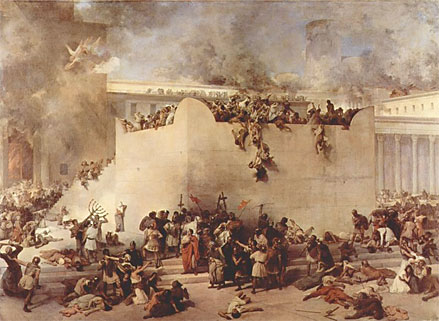The Earth Is Flat

Understanding the “Trinity” of the Bible’s Garden, Land, World architecture is one of the most helpful keys to making sense of the prophets, Matthew 24 and the Revelation. [1] James Jordan writes:
“The Bible repeatedly speaks of the ‘ends’ of the earth. Sometimes the word in Hebrew is ephes, which means ‘end, extreme limits, nothingness.’ Other times it is qatsah or qetsev, which means, again, ‘end, extremity.’ Deuteronomy 13:7, for instance, uses the expression ‘from one end of the earth to the other end.’ The same expression, or a reference to the ‘end of the earth,’ occurs in Deuteronomy 28:49, 64; 33:17; I Samuel 2:10; Psalm 19:4; 22:27; 46:9; 48:10; 59:13; 65:5; 67:7; 98:3; 135:7; Proverbs 17:24; 30:4; Job 28:24; 37:3; Isaiah 5:36; 24:16; 40:28; 41:5; 42:10; 45:22; 48:20; 49:6; 52:10; 62:11; Jeremiah 10:13; 16:19; 25:33; Micah 5:4.
Moreover, not only does the Bible indicate that the earth is flat and has ends, but it also teaches that the earth is square and has corners. Isaiah 11:12 says that God will ‘gather the dispersed of Judah from the four corners of the earth.’ Ezekiel 7:2 says that ‘the end is coming on the four corners of the earth.’ See also Revelation 20:8…
…now, how are we to understand the Biblical language at these points? Well, some references to the ‘ends of the earth’ actually refer to the ends of the land, the holy land (Jeremiah 12:12; Isaiah 26:15), because the Hebrew word for ‘earth’ and for ‘land’ is the same. Similarly, some references to the fixity of the earth actually refer to the fixity of the holy land, that it would not be subject to earthquakes.
But beyond this, the phrase is used figuratively. In Job 38:13, God says He will take hold of the ends and shake, as one shakes a rug. In Psalm 61:2, David, apparently praying in his palace, for he speaks of himself as the king, says that he is calling from the ends of the earth, a figurative usage. Isaiah 43:6 refers to the lands surrounding Israel as the ‘ends of the earth.’
How about the corners of the earth? To understand this, we have to realise that the Bible pictures the earth as a house, as in Job 38:4-6. Moreover, the Bible pictures the earth as an altar, with four corners, in Revelation 7:1; 9:13-21. All of this goes back to the Garden of Eden, which had four rivers flowing out of it to water the whole earth, headed for the ‘four corners.’ The word for ‘corner’ in Hebrew is kanaf, which literally means ‘wings.’ The cherubim have four wings (Ezekiel 1). The garment worn by each Hebrew male was to have four wings or corners, so that his garment was analogous to a house or tent that he carried with him at all times (Numbers 15:38; Deuteronomy 22:12; Haggai 2:12).
What this gives us is a series of analogous models: The Garden of Eden is like a house, and they are like an altar, and they are analogous to the human person (who is the temple of the Spirit), etc…
So, when the Bible uses language that indicates that the earth is flat, that it has ends, and that it has corners, we are to understand such language in its Biblical context. And that Biblical context is the house-model of the world, seen in the glory cloud, the Garden of Eden, the Tabernacle, the Temple, the holy land, the entire earth, the human body, the clothing of the human body, the cherubim, etc. We are not to try to stretch this language to answer cosmological questions that it was not intended to address.”
Now, read the Revelation and every time you come across the word “earth,” replace it with “Land.” Puts a real different spin on things, doesn’t it? [3]
____________________________________________________
[1] See also How To Read the Prophets and Jesus in the Theatre of God.
[2] James B. Jordan, The Geocentricity Question, Open Book Newsletter No. 46, www.biblicalhorizons.com. For an extended treatment of this subject, see the discussions in Through New Eyes: Developing a Biblical View of the World [PDF].
[3] See also Trinitarian Judgments.

























